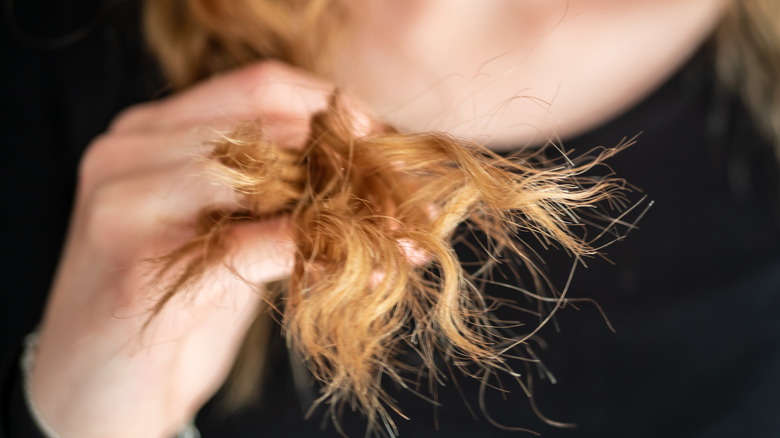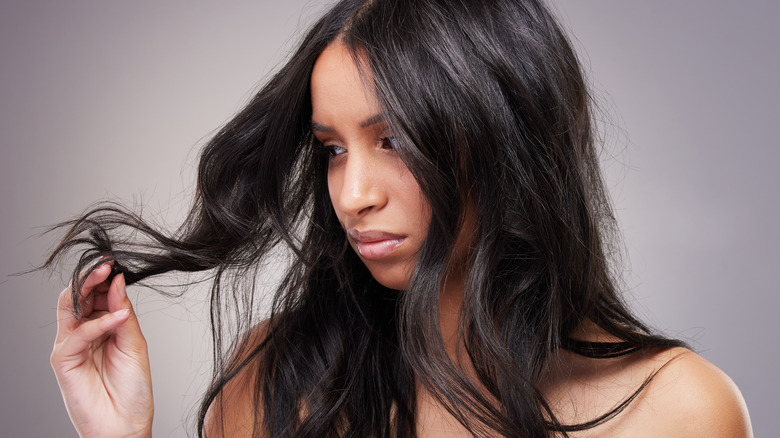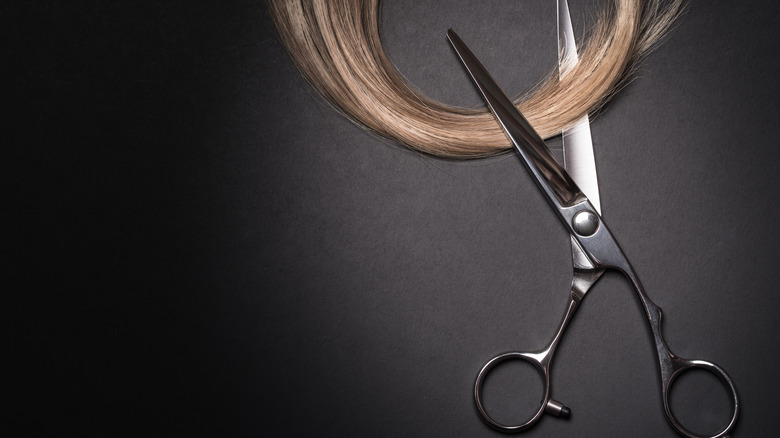Getting Rid Of Pesky Split Ends At Home Is Easier Than You Think
Split ends come in many shapes and sizes, from the standard double split to the multi-frayed tree split. But according to the Ogle School, experts in cosmetology and esthetics, all signal that the hair is dry and damaged. Split ends are incredibly common and anyone can get them, though people with Afro-textured hair or women experiencing menopause may be more likely to notice breakage according to Healthline.
Additionally, chemical hair products, heat styling, and extreme weather (think strong winds or freezing temperatures) can also cause the hair to split. For those with especially damaged or delicate locks, even rubbing shampoo too roughly into it or putting their hair up into a ponytail could cause fraying, as WebMD warns. Clearly, split ends are tough to avoid, and most of us are walking around with at least a few right now.
However, the longer you let them linger, the more damaged your strands will become. Rather than ignoring breakage — or, worse, picking at the splits — the dusting technique can be an effective way to keep damaged ends under control.
What is dusting?
Snipping off split ends is the best way to stop damage in its tracks, and luckily you don't have to lose inches from your hair to do it. Hair dusting is a cutting technique that only targets the split ends, as hairstylist Sal Salcedo explained to Refinery29. "Think of it in terms of removing fuzz from clothes," he noted.
Dusting isn't the same as a regular trim. As celebrity hairstylist Jonathan Colombini summed up to L'Oréal Paris: "Its main benefit is to specifically remove dry or split ends." The technique works by sectioning off hair, pulling it slightly taut, and then chopping the split ends that poke out (Hair.com offers a YouTube tutorial so you can see dusting in action).
By snipping off damaged ends, the splits are less likely to progress up the hair shaft, meaning you'll have a healthier mane without having to get a massive haircut. And while most hairstylists can dust your strands for you, you can also try it out at home whenever you notice pesky split ends.
How to locate split ends
If you're not sure how to spot split ends or if you even have them, one sign of damage is that your hair looks frayed, with the tips branching out in different directions, according to MindBodyGreen. The more splits on each individual hair — sort of like a feather or a tree trunk with multiple branches sticking out — or the deeper the splits, the worse the damage is.
Robin Groover, a hairstylist and the founder of Too Groovy Hair Salon, advised The Zoe Report that locating split ends also depends on your hair type. "Split ends are much easier to detect in straight hair, as curly and coily styles can often mask the true state of hair ends," she explained. "However, hair that becomes stuck or tangled when running your fingers through it is often an easy detector of split ends."
As Groover elaborated, "The split ends create knots for curls and coils on the ends. And as a result, the hair will often break on the ends, resulting in length stagnation."
At-home hair dusting prep
Thankfully, dusting your damaged hair at home is a simple process that requires little prep work. Your tools should include a mirror and scissors. The experts at All Things Hair warn against using just any ol' shears, though. To avoid further damage, they recommend investing in a pair of scissors specifically designed for trimming hair. Additionally, they suggest applying oil to the ends to stave off dryness, though this step isn't compulsory.
If you're really in a pinch, a standard pair of scissors may suffice, as long as they're not dull. "Even nail scissors work, but make sure they're sharp," hairstylist Sunnie Brook told MindBodyGreen. Gather your clippers, and head to a well-lit room with a mirror to get to work. Besides running a little hair oil through your ends, if you choose to do so, your locks should be kept clean and dry. That way, you can clearly see where the splits are located.
How to dust for each hair type
Dusting can benefit all hair types, per L'Oréal Paris, but the technique varies slightly. Hairstylist Raven Hurtado shared the step-by-step process for each with Cosmopolitan. For straight hair, make sure your locks are completely dry. Then, section off one bit, clipping back the rest. Though there isn't one way to expose split ends, Hurtado prefers the twisting method, where you wind a small section of hair and cut away the ends that stick out. Continue this process throughout the entire head.
The procedure is similar for curly hair. Start with dry hair, section it off, and focus on one curl at a time. Pull the hair straight, and then wrap it over your finger so you can clearly see the split ends. Snip away those frizzy tips to keep curls looking fresh. For type-4 hair, dry it completely, section off your strands, and wrap one small piece at a time around your middle finger. Keep the section pulled tight to make finding the split ends a breeze. Trim the splits before moving on to the next section.
How to care for your hair after removing split ends
Dusting your hair at home is a great first step to revitalizing those dry, damaged strands. To maintain a healthy mane, however, prevention is key. Stop those ends from splitting in the first place by keeping your hair conditioned and skipping wash days when you can, as Healthline recommends. Avoid harsh ingredients and chemical treatments, such as bleaching or straightening, which can wreck your locks.
And be sure to properly protect your hair from heat, especially if you regularly rely on blow-dryers and straightening irons. Even if you're super careful, you'll likely notice at least a few split ends over time. To keep them in check, hairstylist Jonathan Colombini suggested dusting every eight to ten weeks (via L'Oréal Paris). When you're ready to get rid of more length or want a new style, head to the salon instead.





